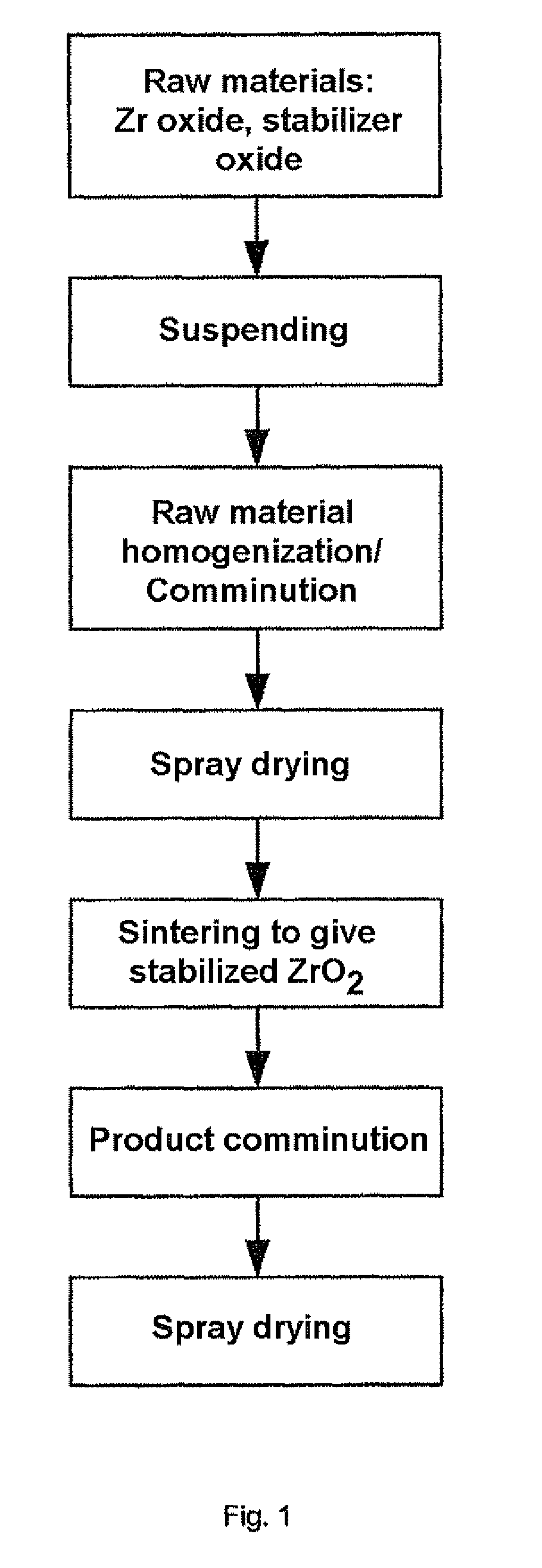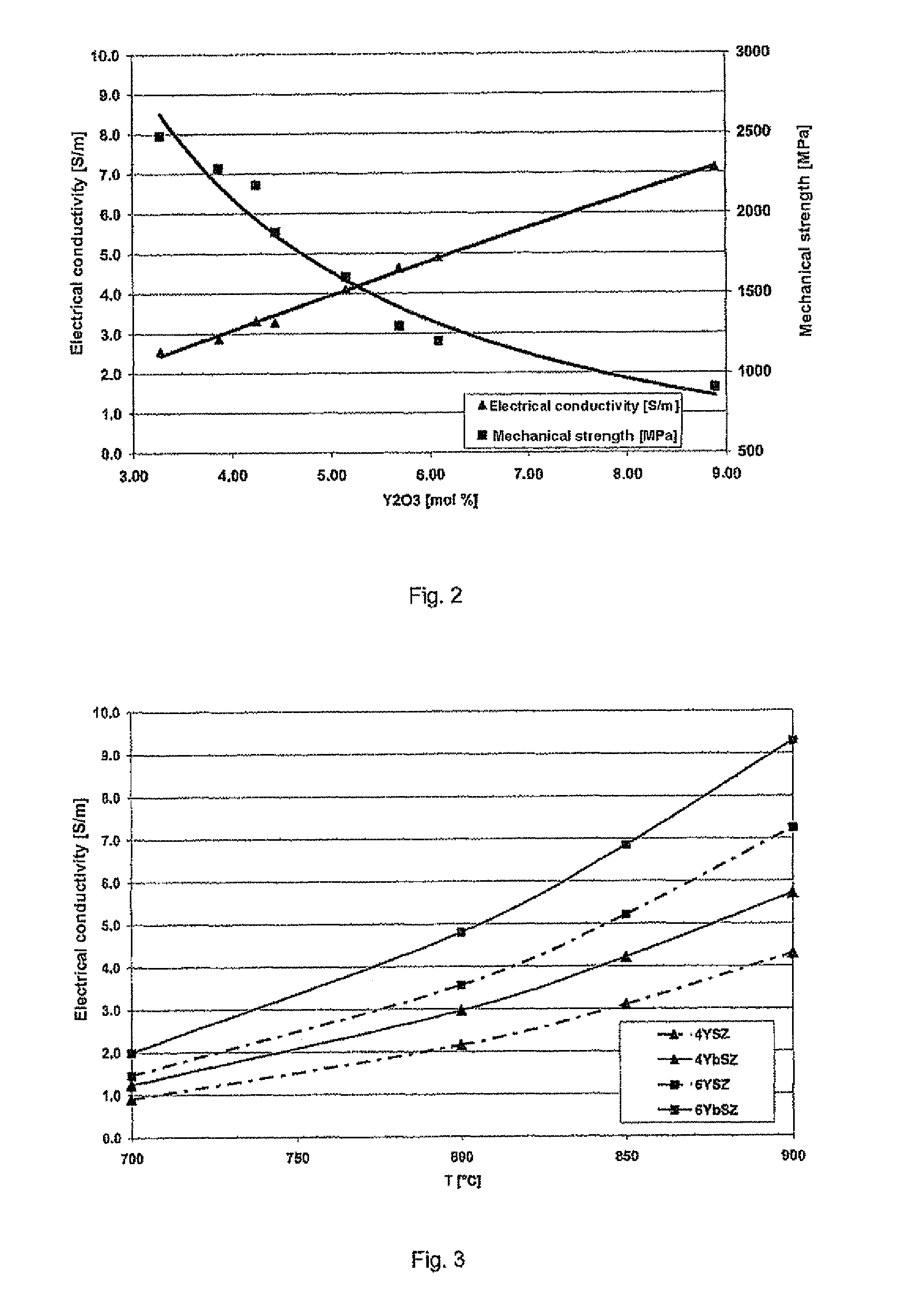Zirconium oxide and method for the production thereof
a zirconium oxide and zirconium oxide technology, applied in the field of zirconium oxide, can solve the problems of large amount of wastewater obtained in chemical processes, unstabilized phase, and large proportion of undesirable monoclinic, and achieve high electrical conductivity and mechanical strength.
- Summary
- Abstract
- Description
- Claims
- Application Information
AI Technical Summary
Benefits of technology
Problems solved by technology
Method used
Image
Examples
example 1
[0087]10.74 liters of deionized water were placed in a water-cooled double-walled reservoir and 23.5 kg of ZrO2 having a specific surface area of 7.54 m2 / g and crystallite edge lengths of a=47 nm, b=58 nm, c=43 nm and 1.56 kg of Y2O3 having a specific surface area of 5.36 m2 / g were suspended by stirring with a high-speed stirrer, i.e. the solids content was 70% by mass. To stabilize the suspension, 0.37 kg of a 1:1 mixture of the two dispersant grades Dolapix CE 64 and Dolapix CA from Zschimmer & Schwarz were firstly added, resulting in an increase in the zeta potential. During milling, further amounts of the Dolapix CA / CE64 dispersant mixture were continuously added in order to continue to achieve sufficient stabilization of the surfaces and charges which had been newly created with progressing comminution, so that the suspension continued to have a low viscosity and could be readily stirred and conveyed during comminution despite a high solids concentration. The suspension was pum...
example 2
[0096]23.5 kg of ZrO2 having a specific surface area of 9.71 m2 / g and crystallite edge lengths of a=36 nm, b=46 nm, c=36 nm and 1.56 kg of Y2O3 having a specific surface area of 5.36 m2 / g were suspended in 10.7 liters of water. The solids content of the suspension was 70% by mass. The homogenized precursor mixture after spray drying displayed a specific surface area of 19.28 m2 / g. The example was carried out by a method analogous to example 1.
[0097]The zirconium oxide powder obtained had a specific surface area of 9.43 m2 / g, a d90 of 0.57 μm and a fill density of 1.84 g / cm3. The Y2O3 content was 3.5 mol %. The proportion of monoclinic phase in the powder was 39% by volume. The powder was uniaxially pressed at a pressure of 100 MPa to give pressed bodies. The pressed bodies were then isostatically pressed at 2000 MPa to densify them further.
[0098]The pressed bodies displayed a green density of 3.49 g / cm3. The density of the pressed bodies after sintering at 1500° C / 1 h was 6.01 g / cm3...
example 3
[0099]66 kg of ZrO2 having a specific surface area of 6.63 m2 / g and crystallite edge lengths of a=50 nm, b=59 mm, c=44 nm and 4.4 kg of Y2O3 having a specific surface area of 3.74 m2 / g were suspended in 47 liters of water. The solids content was 60% by mass. The milling of the precursors was carried out at a specific net milling energy input of 0.50 kWh / kg of solid. The homogenized precursor mixture after spray drying displayed a specific surface area of 14 m2 / g. The further procedure in the example was analogous to example 1.
[0100]The product obtained had a specific surface area of 10.60 m2 / g, a d90 of 0.64 μm and a fill density of 1.72 g / cm3. The Y2O3 content was 3.5 mol %. The proportion of monoclinic phase in the powder was 50% by volume. The powder was uniaxially pressed at a pressure of 100 MPa to give pressed bodies. The test specimens were then isostatically pressed at 2000 MPa to densify them further.
[0101]The pressed bodies displayed a green density of 3.46 g / cm3. The dens...
PUM
| Property | Measurement | Unit |
|---|---|---|
| Temperature | aaaaa | aaaaa |
| Temperature | aaaaa | aaaaa |
| Temperature | aaaaa | aaaaa |
Abstract
Description
Claims
Application Information
 Login to View More
Login to View More - R&D
- Intellectual Property
- Life Sciences
- Materials
- Tech Scout
- Unparalleled Data Quality
- Higher Quality Content
- 60% Fewer Hallucinations
Browse by: Latest US Patents, China's latest patents, Technical Efficacy Thesaurus, Application Domain, Technology Topic, Popular Technical Reports.
© 2025 PatSnap. All rights reserved.Legal|Privacy policy|Modern Slavery Act Transparency Statement|Sitemap|About US| Contact US: help@patsnap.com



